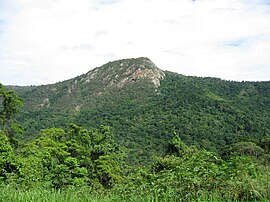
Tully Gorge is a national park in Queensland, Australia, 1,338 km northwest of Brisbane. The park forms part of the Wooroonooran Important Bird Area, identified as such by BirdLife International because it supports populations of a range of bird species endemic to Queensland's Wet Tropics.
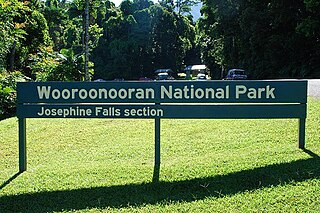
Wooroonooran National Park is a national park in Queensland, Australia, 1,367 km northwest of Brisbane, between Innisfail and Cairns.

Mount Bartle Frere is the highest mountain in Queensland at an elevation of 1,611 metres (5,285 ft). The mountain was named after Sir Henry Bartle Frere, a British colonial administrator and then president of the Royal Geographical Society by George Elphinstone Dalrymple in 1873. Bartle Frere was British Governor of Cape Colony at the outset of the Anglo-Zulu War.

The Wet Tropics of Queensland World Heritage Site consists of approximately 8,940 km2 of Australian wet tropical forests growing along the north-east Queensland portion of the Great Dividing Range. The Wet Tropics of Queensland meets all four of the criteria for natural heritage for selection as a World Heritage Site. World Heritage status was declared in 1988, and on 21 May 2007 the Wet Tropics were added to the Australian National Heritage List.
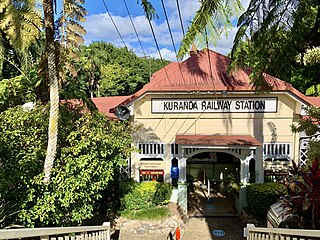
Kuranda is a rural town and locality on the Atherton Tableland in the Shire of Mareeba, Queensland, Australia. In the 2016 census, Kuranda had a population of 3,008 people. It is 25 kilometres (16 mi) from Cairns, via the Kuranda Range road. It is surrounded by tropical rainforest and adjacent to the Wet Tropics of Queensland World Heritage listed Barron Gorge National Park.
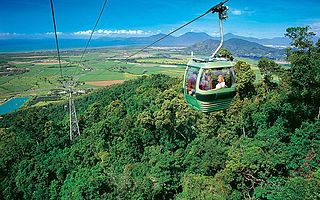
Skyrail Rainforest Cableway is a 7.5-kilometre (4.7 mi) scenic tourist cableway running above the Barron Gorge National Park, in the Wet Tropics of Queensland’s World Heritage Area in Australia. It operates from the Smithfield terminal in Cairns to the Kuranda terminal on the Atherton Tableland. It has won more than 25 awards.
The Barron Gorge Hydroelectric Power Station in Queensland, Australia is an electricity power station commissioned in 1963 with a maximum capacity of 66 megawatts (89,000 hp). It is in the locality of Barron Gorge in the Wet Tropics World Heritage Area 20 kilometres (12 mi) north-west of Cairns. It replaced an earlier station which was the first underground power station in the country and the first hydroelectric station in Queensland. The power station was refurbished in 2006.

Barron Falls is a steep tiered cascade waterfall in Kuranda, Shire of Mareeba, Queensland, Australia. The falls are created by the Barron River descending from the Atherton Tablelands to the Cairns coastal plain.

The Djabugay people are a group of Australian Aboriginal people who are the original inhabitants of mountains, gorges, lands and waters of a richly forested part of the Great Dividing Range including the Barron Gorge and surrounding areas within the Wet Tropics of Queensland.

The Kuranda Scenic Railway is a tourist railway service that operates along the heritage-listed Cairns-to-Kuranda railway line. Constructed in 1891, the line runs from Cairns, Queensland, over the Great Dividing Range to the town of Kuranda on the Atherton Tableland. Along the way, the route passes through the Macalister Range, as well as the suburbs of Stratford, Freshwater and Redlynch. Along the way, the train also stops at a lookout, which provides views of Barron Falls.

Smithfield is a suburb of Cairns in the Cairns Region, Queensland, Australia. In the 2021 census Smithfield had a population of 6,664 people.

The Surprise Creek Falls, a segmented waterfall on the Surprise Creek, is located in the UNESCO World Heritage–listed Wet Tropics in the Far North region of Queensland, Australia.

The Bellenden Ker Range, also known as the Wooroonooran Range is a coastal mountain range in Far North Queensland, Australia. Part of the Great Dividing Range it is located between Gordonvale and Babinda.
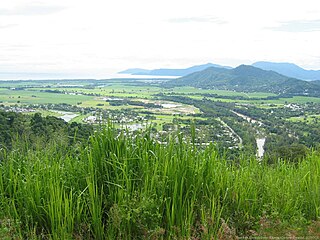
Caravonica is a suburb of Cairns in the Cairns Region, Queensland, Australia. In the 2016 census, Caravonica had a population of 1,989 people.

The Wooroonooran Important Bird Area comprises some 5125 km2 of mainly forested land in the Wet Tropics of Queensland World Heritage Site, of Far North Queensland, Australia.

Kuranda National Park is a national park in Far North Queensland, Australia. Like many national parks in the area it belongs to the Wet Tropics World Heritage Area. The park protects an important wildlife corridor in which rainforest and open eucalypt forest predominate. Walking, mountain biking and four-wheel driving are popular recreational activities.

The Cairns-to-Kuranda Railway is a heritage-listed railway line from the Cairns Region to the Shire of Mareeba, both in Queensland, Australia. It commences at Redlynch, a suburb of Cairns and travels up the Great Dividing Range to Kuranda within the Shire of Mareeba on the Atherton Tableland. It was built from 1913 to 1915 by Queensland Railways. Components of it include Stoney Creek Bridge, the Rail Bridge over Christmas Creek, Kuranda railway station, and Surprise Creek Rail Bridge. It was added to the Queensland Heritage Register on 21 August 1992. The railway is used to operate a tourist rail service, the Kuranda Scenic Railway. It forms part of the Tablelands railway line.

Barron Gorge is a rural locality in the Cairns Region, Queensland, Australia. In the 2016 census Barron Gorge had a population of 0 people.

Macalister Range is a coastal locality in the Cairns Region, Queensland, Australia. In the 2021 census, Macalister Range had a population of 0 people.

Kuranda Fig Tree Avenue is a heritage-listed avenue of trees at Coondoo Street, Kuranda, Shire of Mareeba, Queensland, Australia. It was built in 1931. It is also known as Avenue of Ficus Microcarpa and Ficus Obliqua trees. It was added to the Queensland Heritage Register on 27 July 2018.
